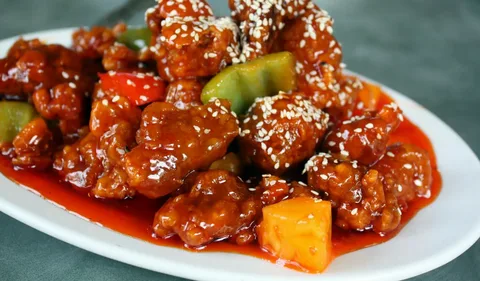Introduction: Unveiling the Magic of Sweet and Sour Pork
In the realm of delectable Chinese cuisine, few dishes can rival the timeless appeal of Sweet and Sour Pork. With its harmonious blend of flavors and textures, this dish has captured the hearts and taste buds of food enthusiasts worldwide. Let’s embark on a culinary journey to explore the secrets behind this beloved delicacy.
A Brief History: Tracing the Origins of Sweet and Sour Pork
Sweet and Sour Pork, a quintessential dish in Chinese cuisine, has become a beloved staple in many parts of the world. Its combination of tangy, sweet, and savory flavors, along with its crispy texture, has won the hearts and palates of countless food enthusiasts globally. But where did this iconic dish originate, and how has it evolved?
The roots of Sweet and Sour Pork can be traced back to China, where it emerged as a part of traditional Chinese culinary practices. Chinese cuisine is renowned for its diverse range of flavors, techniques, and regional variations, and Sweet and Sour Pork exemplifies this rich culinary heritage.
The dish likely originated in the Guangdong province of southern China, which is known for its bold and vibrant flavors. Guangdong cuisine, also known as Cantonese cuisine, emphasizes the use of fresh ingredients, subtle seasoning, and precise cooking methods. Sweet and Sour Pork perfectly embodies these culinary principles with its harmonious balance of flavors and textures.

The exact origins of Sweet and Sour Pork are somewhat elusive, but it is believed to have been created during the Qing Dynasty (1644-1912) or possibly even earlier. During this period, Chinese cuisine underwent significant development, influenced by various factors such as trade, cultural exchange, and the availability of ingredients.
One theory suggests that Sweet and Sour Pork was originally devised as a way to preserve and enhance the flavor of pork, which was a staple protein in Chinese cuisine. By combining vinegar, sugar, and other seasonings, cooks could create a tangy-sweet sauce that not only added flavor but also helped to tenderize the meat.
As Chinese immigrants began to settle in other parts of the world, they brought their culinary traditions with them, including the recipe for Sweet and Sour Pork. This dish quickly gained popularity in Chinese-American communities, where it was adapted to suit local tastes and ingredients.
In the United States, Sweet, and Sour Pork underwent further evolution, reflecting the fusion of Chinese and American culinary influences. Americanized versions of the dish often feature a thicker, sweeter sauce made with ingredients like ketchup and pineapple juice, giving it a distinctively sweet flavor profile.
Over time, Sweet and Sour Pork became a staple of Chinese-American cuisine, appearing on the menus of Chinese restaurants across the country. Its popularity continued to grow, fueled by its bold flavors, colorful presentation, and accessibility to a wide range of palates.
Today, Sweet and Sour Pork can be found in Chinese restaurants and takeout establishments around the world, as well as in home kitchens where adventurous cooks seek to recreate its classic flavors. While variations abound, the essence of the dish remains true to its origins—a delightful combination of sweet, sour, and savory flavors that continue to captivate diners of all ages.
In conclusion, the history of Sweet and Sour Pork is a testament to the enduring appeal of Chinese cuisine and its ability to adapt and evolve. From its humble origins in southern China to its status as a global culinary icon, this beloved dish has left an indelible mark on the world of food, showcasing the richness and diversity of Chinese culinary heritage.

Ingredients: The Building Blocks of Flavor
Creating the perfect Sweet and Sour Pork requires a careful selection of ingredients. The star of the show is undoubtedly the pork, typically cut into bite-sized pieces and marinated to infuse it with flavor. Other key components include bell peppers, onions, and pineapple chunks, which add vibrant colors and complementary tastes to the dish.
Cooking Technique: Mastering the Art of Balance
The hallmark of exceptional Sweet and Sour Pork lies in achieving the perfect balance of sweet and tangy flavors, along with a satisfying contrast of textures. To achieve this, the pork is first coated in a light batter and fried until golden and crispy. The sauce, a tantalizing blend of sugar, vinegar, ketchup, and other seasonings, is then meticulously prepared and added to the mix, resulting in a harmonious symphony of tastes and textures.

Serving Suggestions: Pairing Perfection
Sweet and Sour Pork is a versatile dish that pairs well with a variety of accompaniments. Whether served alongside steamed rice for a simple yet satisfying meal or presented as part of a lavish banquet spread, its vibrant colors and irresistible aroma never fail to captivate diners.
Conclusion: A Culinary Classic Worth Savoring
In conclusion, Sweet and Sour Pork stands as a shining example of culinary excellence, captivating palates with its irresistible blend of flavors and textures. From its humble origins to its status as a beloved international delicacy, this dish continues to enchant food enthusiasts of all ages. So, the next time you’re craving a taste of something truly special, why not indulge in the timeless allure of Sweet and Sour Pork? Your taste buds will thank you for it!